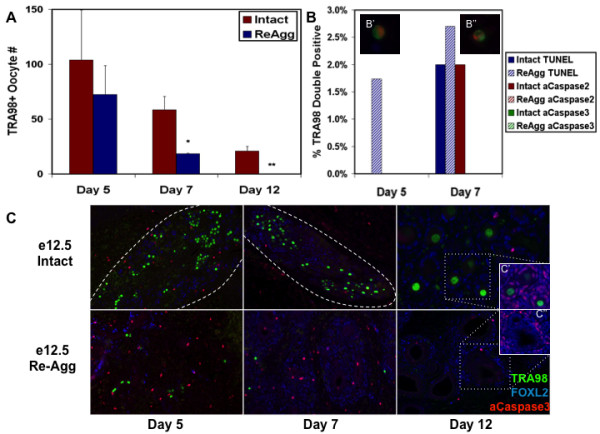Figure 4.

Re-aggregation obstructed intact ovarian cord structure and induced Caspase-independent oocyte loss before follicle formation. (A) The numbers of surviving oocytes per graft were determined by TRA98 immunofluorescence following five, seven, and 12 days of intact or re-aggregated (re-agg) e12.5 female genital ridge transplantation revealing oocyte loss by d7 before follicle formation on d12. Error bars represent s.d. (n = 3) */** = p < 0.05 between d7/d12 re-aggregated and intact, respectively. (B) Re-aggregation induced oocyte loss was Caspase-independent. The percentage of TRA98+ oocytes (100 cells/graft) undergoing apoptosis was assayed by TUNEL and active Caspase2 or Caspase3 co-immunofluorescence following five to seven days of transplantation. Intact = solid bars. Re-aggregated = striped bars. TUNEL+ (red) apoptotic oocytes co-stained for TRA98 (green) were detected in re-aggregated samples following 5 (B') and 7 (B'') days of transplantation (C) Ovarian cord structure was examined by TRA98 germ cell and FOXL2 granulosa somatic cell immunofluorescence over 12 days of e12.5 female genital ridge transplantation. Oocytes and granulosa cells clustered together in defined ovarian cord-like structures (dashed lines) following five to seven days of intact sample transplantation, and ovarian follicles were detected by day twelve. Re-aggregated samples did not form ovarian cords or follicles during the time course, and TRA98+ oocytes were not detected after day seven in re-aggregated transplants. Active Caspase3 was not detected in oocytes. (C' and C'') Clusters containing FOXL2+ cells were observed following re-aggregation, however, FOXL2+ cells were only detected at the perimeter of these clusters, and neither FOXL2+ nor TRA98+ cells were ever observed at the interior in contrast to intact ovarian follicles. C' and C'' panels: DAPI - blue, FOXL2 - red, and TRA98 - green. 100× magnification.
